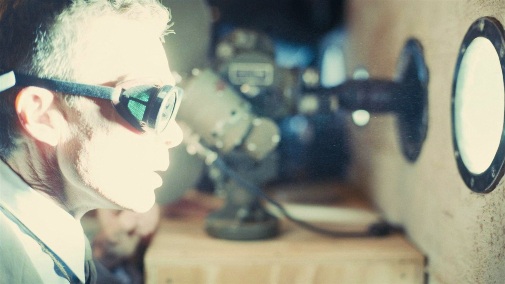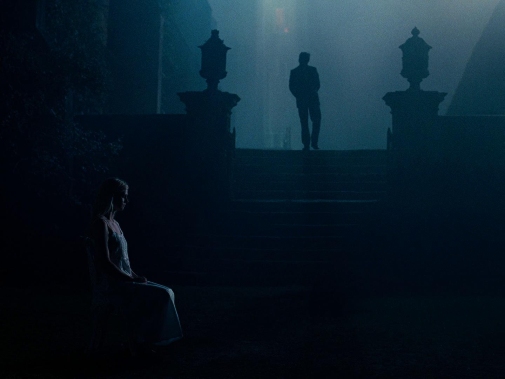Team Experience is discussing each Oscar category before the nominations are announced. Here's Eric Blume and Lynn Lee to talk Best Cinematography...

ERIC: We have the pleasure of discussing the insanely talented cinematography candidates this year. It seems like this year's two big awards players, Oppenheimer and Killers of the Flower Moon, will certainly make the slate here...so, can I say, why I am not particularly excited about the work of either Hoyte van Hoytema and Rodrigo Prieto for these two films? Don't get me wrong, both are beautifully lensed films and these men are brilliantly talented, but their work seemed more standard than inspired.
Neither world, neither Oppenheimer's labs and offices nor Moon's flat plains, are the most visually exciting terrains, and while both men work with their respective directors to build a few lovely frames, I was definitely more knocked out by the imagery in some other films this year...
What is your thought on the two big guns here?

LYNN: Honestly, the cinematography was one of the few things I really liked about Killers outside of Lily Gladstone - although it's admittedly a bit difficult to separate from the (also excellent) production design and costumes. What Prieto et al. do very well is create a sense of a place that has the semblance of prosperity and order, even beauty, but is deeply tainted and threatened - embodied in that indelible early image of the Osage joyfully dancing in the surge of their newly discovered oil. While the film's more violent sequences recall Scorsese's gangster pics, the scenes with Gladstone and DiCaprio in the middle section are shot like a slow-burn psychological horror movie, which seems to me exactly right.
As for Oppenheimer, who needs exciting terrains when you've got Cillian Murphy's eyes and cheekbones? I'm only half kidding.
Much of the film's visual impact lies in its intense focus on this intensely unknowable man whose face conveys everything and gives away nothing. And I'd argue that van Hoytema shoots the lab scenes with a dynamism that effectively evokes the excitement of the scientists working with theoretical ideas that would eventually literally light the world on fire. They culminate in the Trinity test sequence, which I thought really conveyed the terrifying grandeur of that moment, and that haunting after-action scene where Oppenheimer, in a room rocking with applause, imagines everyone in it getting exposed to the A-bomb. These are images that have definitely stuck with me.
So which movies' cinematography are you most excited about, Eric? And do you think they have a shot at Oscar?

ERIC: I think probably next in line in likelihood of a nomination is Robbie Ryan's work in Poor Things. Some might argue that it's just showy stuff, what with all the iris shots, fisheye lenses, distortions, etc., but Ryan and Lanthimos' choice to use these techniques aren't just to show of a bag of tricks. Everything is purposeful in this film, and the cinematography is one of the key elements to keeping the audience off-balance and transported into a unique time and place. Ryan makes the movie feel turn-of-the-century, futuristic, and timeless in equal measure, and his palettes change as Bella changes. It's one of those astonishing movies where the camera department, art department, costume department, and actors are in such freakishly precise lock-step with each other as the story develops and all of the elements morph and mature as it goes. It's really astonishing work.
I'm also high on what Linus Sandgren does in Saltburn. In a world where so many current films are just simply underlit, Sandgren gives us a burnished golden feel in the early scenes on campus, and then pushes it even further upon arrival at Saltburn, working with that great set decoration for some gorgeously-framed images of the characters in relationship to the mansion. His work in all of the night scenes, compositions using the angel and minotaur statuary and evening fog, is gorgeous. His work stops just sort of lurid, key for a film that is hovering in and out of lurid throughout, giving the film some class and verve.

And Matthew Libatque's work on Maestro is one of the film's finest elements. Much like Florian Hoffmeister with TÁR last year, Libatique feels firmly in control of the classical music sequences, working in huge spaces to keep things intimate until there's a need for larger grandeur. And he and Cooper pull off one of the most ravishing shots of the year: that absurdly high camera with Carey Mulligan's Felicia offstage, slowly engulfed by Bernstein's shadow as he conducts. The shot is so on-the-nose metaphorically that it should be clumsy and obvious, but Libatique executes it with such artistry that it soars. And Libatique even handles Cooper's missteps (e.g., that ill-fated On The Town dance sequence that becomes fantasy when Cooper "dances") with flair and panache. Libatique and Cooper are a great pair, they seem to inspire each other, and there's lots of beautiful work throughout the film.
What are you feeling thrilled about this year?
LYNN: Alas, I haven't yet had a chance to see Poor Things (it's that time of year when I really chafe at not living in either NY or LA), but based on what I've seen I agree it's a strong contender. Even if I find the Lanthimos/Ryan fisheye obsession distracting!

100% with you on Maestro. Libatique's doing some seriously virtuosic and rangey work that doesn't feel like showing off so much as channeling the exuberance of Bernstein's genius. I love how seamlessly he shifts between reality and fantasy - as in that dance sequence - or just compresses reality, like in that early overhead tracking shot where Bernstein rushes out of his apartment seemingly right onto the Carnegie Hall stage. And that climactic performance of the Mahler 2 finale in Ely Cathedral - which prompted applause in the theater where I saw it - owes a lot, obviously, to Cooper conduct-acting (condacting?) his heart out...but if you compare it with the original, which you can watch on YouTube, you also appreciate not just the faithfulness of the recreation but the energy and fluidity of Libatique's camera, matching that of the conductor who's reached a whole new artistic pinnacle.
He also knows when to draw back, though - literally. I'm thinking of that delightfully ludicrous image of the giant Snoopy balloon from the Macy's parade, bobbing outside the window as the ironic punctuation mark to a knock-down, drag-out marital fight. Or a much later, sadder glimpse through a window, this time at the Bernsteins' Fairfield home, when we see first the youngest Bernstein kid, then Bernstein, then the two other kids, run outside, overcome with grief. We never see their faces or hear what they say, yet even from that angle, that distance, their dress, their posture, and the overcast sky tell us what we need to know more eloquently than any close-up could.

While I didn't care for Saltburn, I could definitely see it getting traction in this category - the cinematography is as scrumptious as the script is (sorry) undercooked. However, the film I'm eyeing for that fifth spot is in many ways its diametric opposite: The Zone of Interest, or what I only half-jokingly call "Auschwitz pastoral." Łukasz Żal shoots each scene of tranquil, thriving Nazi domesticity with an unnervingly dispassionate, almost clinical precision that soon comes to feel as oppressive as the muffled nightmare of the soundscape and Mica Levi score.
There are no close-ups, at least of people, that I recall; everyone is filmed in medium or long shot. The abundant use of fixed cameras puts us at even more of a remove, as we repeatedly watch figures walk down the same echoing corridor or observe the same garden, flanked by the same high gray wall and (fed by) the distant smokestacks, come into increasingly, nauseatingly extravagant bloom. (Thanks to this film, I'll never look at gardens the same way again.) When he does swerve - whether to a stealthy night scene filmed with thermal imaging or a momentary fast-forward to a crushing image from the present day - the emotional contrast is all the more jarring. Zone of Interest may ultimately be too cold to snag a nomination here, but I think it at least stands as good a chance as Saltburn, if not better, especially if it overperforms in other categories.
What else could slip into the lineup? And what do you make of the fact that between Poor Things, Oppenheimer, and Maestro, we may end up with a majority of nominees that were filmed in both black & white and color? Coincidence or sign of a broader trend?
Also, could Pietro double-dip with Barbie?

ERIC: I was also thinking of the fact that we'll have THREE films in both color and black and white! Certainly that's a first?
I think Lukasz Zal is in for a nomination. They've nommed him for Ida and Cold War, so his peers are eager to see his next work, and this is a step away from what he's done for Pawel Pawelowski. Zal's antiseptic approach is key to the entire film working, and the decision by him and Glazer to never bring any of the actors close to us...and suspending a film with just distant framing for an entire feature...will be viewed as very envious by the other cinematographers. They take that idea from being just a stunt into something textured and mature, and of course impossibly right for the nature of the film.
I don't think Prieto will double dip, because there are too many other options this year. I think one other big contender here is Erik Messerschmidt's work in Ferrari, since he was the winner recently for Mank, and since he's David Fincher's go-to guy right now, he's on everyone's radar. He gets a nice chiaroscuro element for Michael Mann here, and it feels like the kind of "suprise" nomination we find on Oscar morning.
And I'm wondering about your thoughts on who might be that "even bigger surprise" that the Academy cinematographers nominate that nobody really sees coming, a la Bardo or Never Look Away. My vote this year would be Jonathan Ricquebourg for The Taste of Things. Ricquebourg is working with two of the world's greatest assets...French food and Juliette Binoche's face...and his creamy approach to both make the film deeply sumptuous.

Your thoughts on final possibilities or surprises? And who are you predicting and rooting for?
LYNN: Hmm, I'm bad at predicting Oscar surprises...or thinking like a cinematographer, for that matter. But one title that popped into my head, although I haven't seen it, is El Conde. I was a little surprised at how quickly it slid off the radar after its premiere at Venice, especially for a Pablo Larrain film. I'm probably too squeamish to watch it, but from what I've seen it looks gorgeous and it's shot by Edward Lachman, who's done beautiful work with Todd Haynes (and been nominated twice previously for it).
However, I'm playing it safe with my final predictions:
- Rodrigo Prieto, KILLERS OF THE FLOWER MOON
- Hoyte van Hoytema, OPPENHEIMER
- Robbie Ryan, POOR THINGS
- Matthew Libatique, MAESTRO
- Łukasz Żal, THE ZONE OF INTEREST
I think that's a pretty strong lineup, and one I'd actually be happy with overall. You?
ERIC: I’ll second your predictions exactly, with the possibility of Saltburn taking out Maestro or Zone of Interest. Any way you look at it, though, an embarrassment of riches this year!

RELATED READING:
- Other Oscar Volleys – Makeup, Editing, Production Design, Costumes, Adapted Screenplay, Original Screenplay, Original Song, International Film, Supporting Actress, Actor & Actress
- Nathaniel’s Oscar Charts
- Team Experience Predictions – From Picture to Screenplay